Walking Tour of Revival-Era Plovdiv
26.07.2012 § 2 Comments

Plovdiv, along with being the site of numerous monuments from its Roman-era past as provincial capital, was also a thriving medieval fortress and an important regional city during the Ottoman rule in Bulgaria and the period of National Revival.
Three of Plovdiv’s six hills are home to an extremely well-preserved Revival-era old town. Housing the city’s art gallery, numerous museums and Revival-era homes preserved and opened to visitors, the Old Town is a must-see during a visit to Plovdiv. Many of the houses on the tour have courtyards walled in by high brick fences, and all feature smaller-area foundations and second and third floors that jut out into the street.
This walking tour will be described as a loop, with one easy entry point from Djumaya mosque square. Keep in mind that, although it’s not clear on the map, this walk involves a few hours of walking up and down hills on cobbled streets. Wear comfortable shoes! Also, unless otherwise stated, museum exhibits are bilingual and available in English. The tour starts in the middle of the main pedestrian street, at Djumaya square.
1. Djumaya Mosque (A)

Djumaya Mosque
The mosque predates the final conquest of Bulgaria, having been built by the Ottomans in the late 1300’s after the fall of Plovdiv. It is built in the older Islamic style, with nine domes resting on four huge internal pillars, which makes it very similar to the mosque in Cordoba. It is an imposing cultural monument and a universal landmark of the city. Any cabbie in Plovdiv can take you to “Djumayata”.
You’ll find the front entrance of the mosque on Saborna street, behind the rolling moat of the Ancient Stadium of Philippopolis.
2. Ascension of the Virgin Mary (“Sveta Bogorodica”) Church (B)

Sveta Bogorodica Church
Instead of taking Saborna, look for the passage behind the mosque, on Krivolak St. Walk past the mosque’s rear along Krivolak for a few blocks and you’ll see a V-shaped intersection. The left side is closed off with a car barrier, and the right is a steep set of stairs leading up to a tall pink tower – the bell tower of the city’s cathedral church – “Ascension of the Virgin Mary”. Built in 1844, it’s a prime example of the Revival period, signalling the start of Bulgaria’s struggle for church independence. It was here that the Plovdiv bishop Paisii read a holy liturgy in Bulgarian, declaring his separation from the Istanbul patriarchate and petitioning the sultan for an independent church. After a few years of struggle, the autocephalous Bulgarian church was re-established in 1870. You’re welcome to enter the church, as it is beautiful inside.
3. The Ancient Theatre (C)
The Roman-era Ancient theatre is on the Old Town hill, and it’s described in detail in my post on Roman architecture in Plovdiv. If you haven’t ventured out to see it on your Roman walk, you should head up the stairs past the church, then down Todor Samodumov street, then turn right on Tzar Ivailo.
4. The Lamartine House (D)
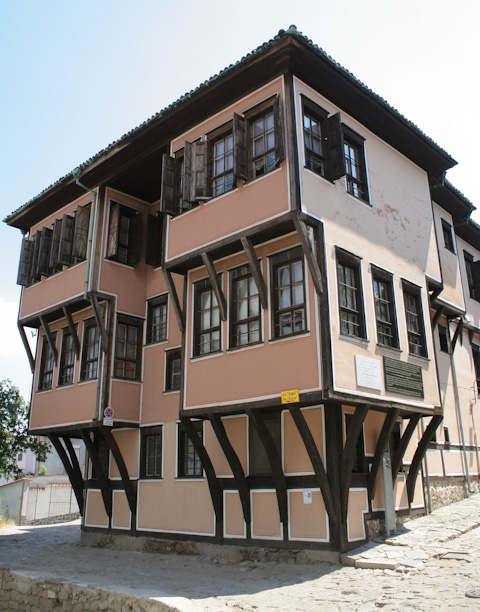
The Lamartine House
Take Tzar Ivailo back and continue right along Todor Samodumov for one more block. You’ll see this yellow house on the corner.
This is the Mavridi house, known as the Lamartine house because French national poet Alphonse de Lamartine stayed there briefly in the summer of 1883. It houses an exhibit devoted to the poet, and is a prime example of symmetric Revival architecture.
5. The City Art Gallery (E)
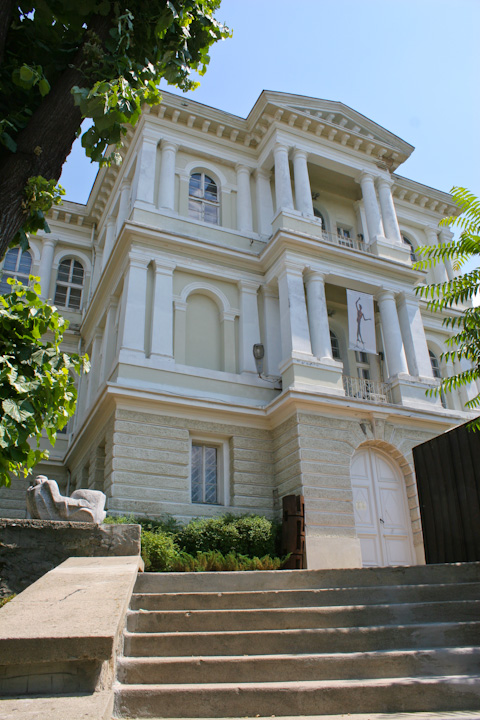
The City Art Gallery
Go back the way you came along Todor Samodumov and turn right at the first opportunity. The street name should be Stoyan Chalakov. Walking down, on your right you’ll see a set of stairs and a socialist realism mural leading up to a pale brown house.
This is the main building of the City Art Gallery. On two compact floors, it has a great collection of Bulgarian art from the late 1800’s to present day, including paintings of Vasil Levski, self-portraits of many renowned painters who worked in Bulgaria, and a scale model of the monument to Tzar Liberator in Sofia. Entrance to the gallery costs 2 Leva (1 for students), and a guided visit is 10 Leva in English.
5.5. The Gallery’s Icon Collection (F)
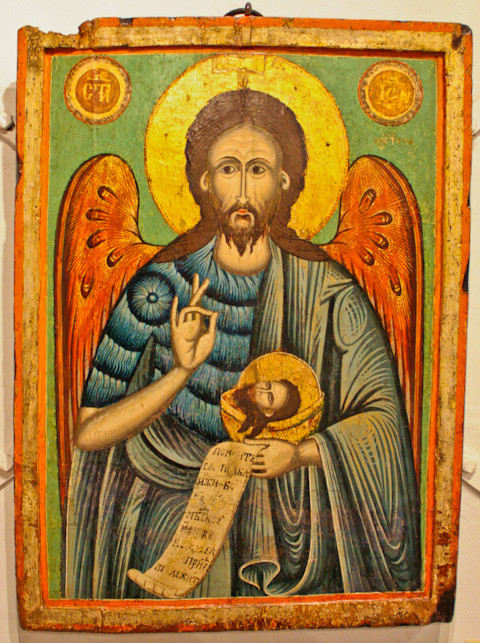
An icon from the Icon Collection
Half a block down the street, on Saborna St. 22, you can find a branch of the City Gallery devoted to iconography: the Eastern Orthodox art of painting images of saints and religious scenes. Entrance to the gallery costs 2 Leva (1 for students), and a guided visit is 10 Leva in English.
6. Sv. Konstantin & Elena Church (G)

The bell tower of St. Konstantin & Elena church
Just behind the Icon Collection, you will see a church’s bell tower jutting out above a walled-in garden. Go inside and you’ll see the facade of the beautiful Sv. Konstantin & Elena church. Entrance is free, as it is in all churches in the country, but picture-taking is not allowed inside.
7. Hisar Kapia and the Round Tower (H)

The Hisar Kapia gate
After the church, take a right and you’ll see the arch of one of the gates of the ancient fortress of Hisar Kapia, built in the 5th century AD. If you turn right again along the ancient wall that the gate hints at, you’ll reach the foundations of a round Byzantine-style tower. These are small remnants of Plovdiv’s Byzantine-era past.
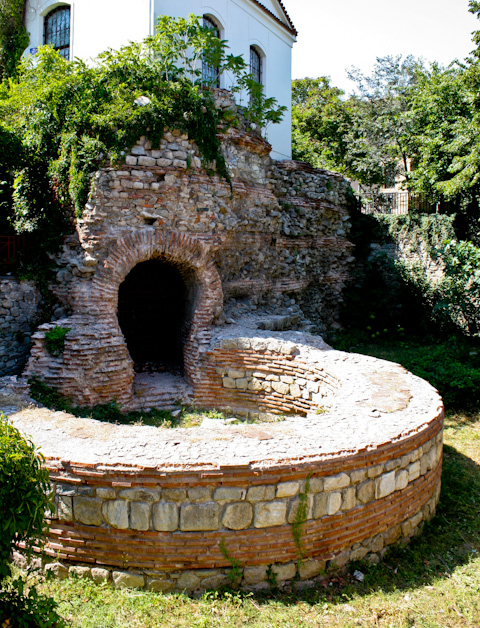
The round tower
8. Museum for National Revival (I)
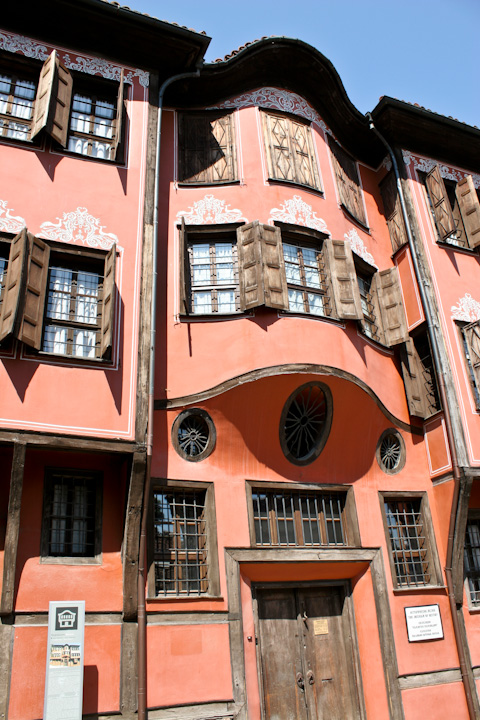
Museum for National Revival
Coming back from the Round Tower, with the Hisar Kapia gate on your left, you’ll see a big orange house ahead of you. This is the National Revival museum that houses exhibits on city life in the final years of Ottoman dominion, as well as weapons and stories from the April uprising of 1876, the Russo-Turkish war of 1877-78, and Plovdiv’s liberation. Be warned, not all the museum’s exhibits are bilingual, although there are explanatory sheets in English posted at the entrance to each exhibit room. Entrance is 2 Leva (1 Lev for students) and a guided tour of the museum costs 6 Leva. Picture-taking will set you back another 1 Lev.
9. Ethnographic Museum (J)

The Ethnographic Museum
Walk back through the Hisar Kapia gate and turn right down Dr.Chomakov street, keeping your eyes open to the right.
Walled behind a high brick fence, the most beautiful house in the Old Town also houses the city’s Ethnographic museum, i.e. the place to see what life looked like in Revival-era Plovdiv, both in the nearby villages and in the city itself. The exhibits, co-sponsored by National Geographic Bulgaria, are well arranged and decidedly worth seeing. Entrance to the museum is 5 Leva (1 Lev for students) and a guided tour in English will cost you 10 Leva.
NOTE: The Ethnographic museum is CLOSED Mondays.
10. Nebet Tepe (K)
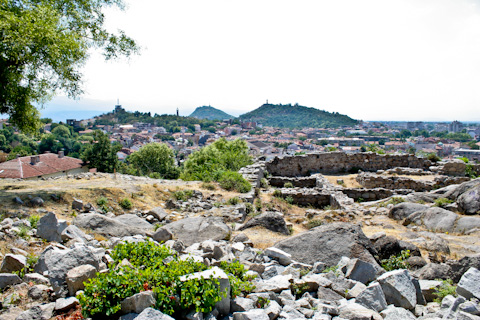
View of Plovdiv from Nebet Tepe’s fortress
Nebet Tepe (the “Nebet Hill”), one of the Old Town’s three hills, at the end of Dr. Chomakov Street, is peppered with the ruins of an ancient Thracian fortress. While not a savoury place to visit after dark, it offers incredible views of Plovdiv. Additionally, just before the path up to the fortress, on the left you will find the Bakalov house, where traditional artisans offer demonstrations of their crafts and sell their wares.
11. Balabanov and Hindliyan Houses (L)

The Hindliyan House
Go back down Dr. Chomakov street until the square before St. Konstantin & Elena. The street leading right will be called Antranik, and on the corner you’ll see the pink Balabanov House. Walk around it until you see the small gate in the wall. You can enter through there. The Balabanov house, as well as the adjacent Hindliyan house in blue (that you can reach from the Balabanov courtyard), are both perfectly restored Revival homes, housing an art gallery and a recreation of the Baroque-era sitting rooms of wealthy Bulgarian merchants in one, and a basement Turkish bath in the other. Entrance to each of the houses is 5 Leva (1 for students), and a guided tour costs 15 Leva.
12. Art Gallery Philippopolis (M)
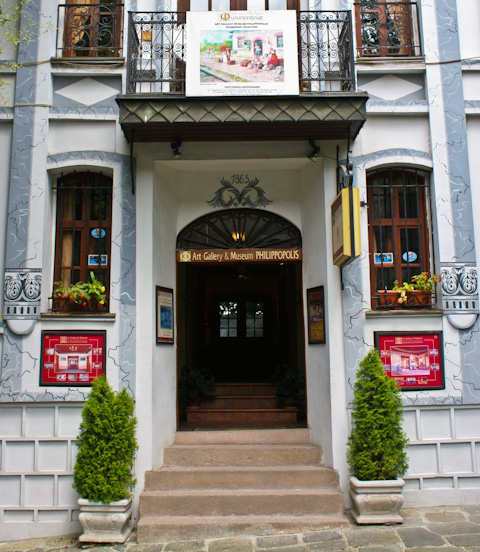
Art Gallery Philippopolis
When you’ve finished with the two houses, head back to the square and turn right, taking Saborna back towards the entrance to the Old Town. At the intersection with Vasil Kanchev and Stoyan Chalakov, Saborna veers slightly to the right. You should follow it, and at number 29, you’ll find the house of Hadji Aleko, currently private art gallery Philippopolis. It’s another beautiful Revival-era house (built around 1865).
Your tour ends at the end of Saborna, at the barrier near the stairs. Walking onwards will return you to Djumaya square, past the area known as Kapana, full of artisan shops.
Plovdiv’s Roman Treasures: A Walking Tour
25.07.2012 § 8 Comments

In 1968, the sports field of the Pedagogy Institute in Bulgaria’s second-largest city, sun-drenched Plovdiv, was scheduled for refurbishment. A company of the Army’s construction corps was assigned to expand the field, which involved digging deeper into one of the city’s three hills. However, the Institute never got its field, because what the diggers found underneath were the curved marble seating rows of an immaculately preserved outdoor Roman theatre.
Plovdiv, inhabited continuously since 4000 BC and Europe’s third-oldest city (after Athens and Argos), is known by many names. Settled by the Thracians as Eumolpias, it was conquered by Philip II of Macedon, the father of Alexander the Great, and given the name Philippopolis. After the decline of the Macedonian kingdom, it reverted to the Thracians, who called it Pulpudeva. When the Romans swept onto the Balkans, they called it Trimontium (“City of Three Hills”) and made it a cultural and economic hub of the Roman province of Thrace. The via militaris, one of the Roman empire’s arterial roads, passed through the city, and it thrived on the banks of the Hebros (Maritsa) river, at one time containing numerous public buildings, baths, shrines, villas, with high walls and a Roman grid system in its streets. This walking tour will take you on a trip through its main Roman-era sights.
« Read the rest of this entry »
Tourist Information Centre Sofia
21.07.2012 § Leave a comment
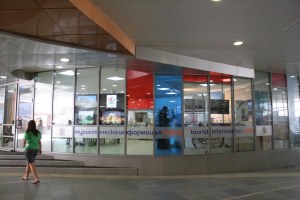
Recently opened in the Sofia University underpass (a.k.a. “Rektorata”, “SU Kliment Ohridski”, etc.), near a big transit ticket office and literally across metro station “SU Kliment Ohridski”, stands the office of the Municipality of Sofia’s Tourist Information Centre. Inside, you can find detailed maps of the city, information about tours and events and helpful, English-speaking staff.